ENGT5220 Industrial Energy Systems: Enhancing Brewery Efficiency
VerifiedAdded on 2023/06/08
|10
|2170
|355
Report
AI Summary
This report provides an in-depth analysis of industrial energy systems, focusing on improving energy efficiency and performance within a small brewery firm in Latvia. The study evaluates the brewery's energy consumption, distinguishing between thermal and electrical energy usage, and compares the findings against industry benchmarks. The production process, from malt milling to beer packaging, is examined to identify areas of energy loss and potential improvements. The report highlights the importance of energy management and operational planning to reduce costs and enhance overall energy efficiency in small-scale breweries. It references key studies and methodologies for assessing and optimizing energy use in industrial settings, ultimately aiming to eliminate hurdles in industrial energy consumption.
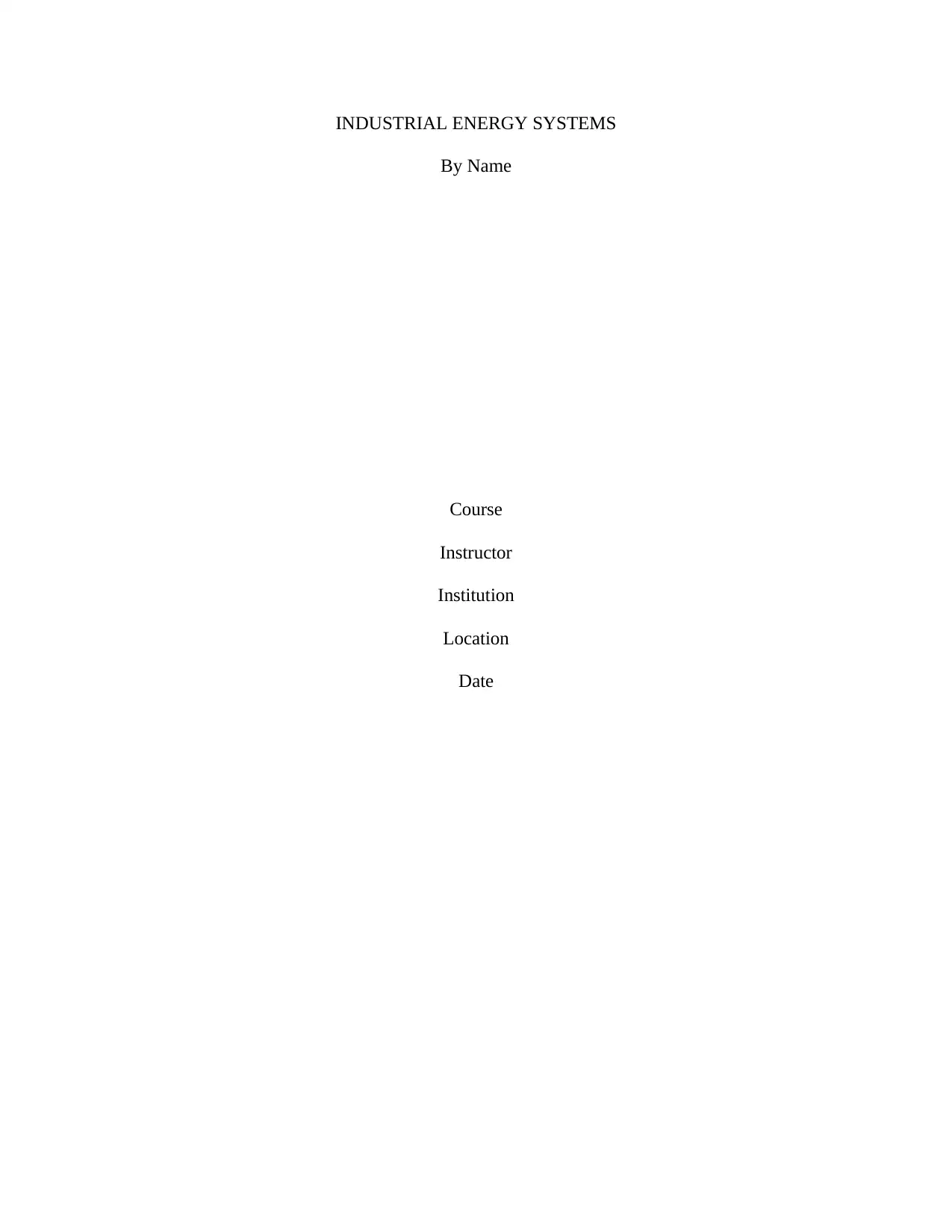
INDUSTRIAL ENERGY SYSTEMS
By Name
Course
Instructor
Institution
Location
Date
By Name
Course
Instructor
Institution
Location
Date
Paraphrase This Document
Need a fresh take? Get an instant paraphrase of this document with our AI Paraphraser
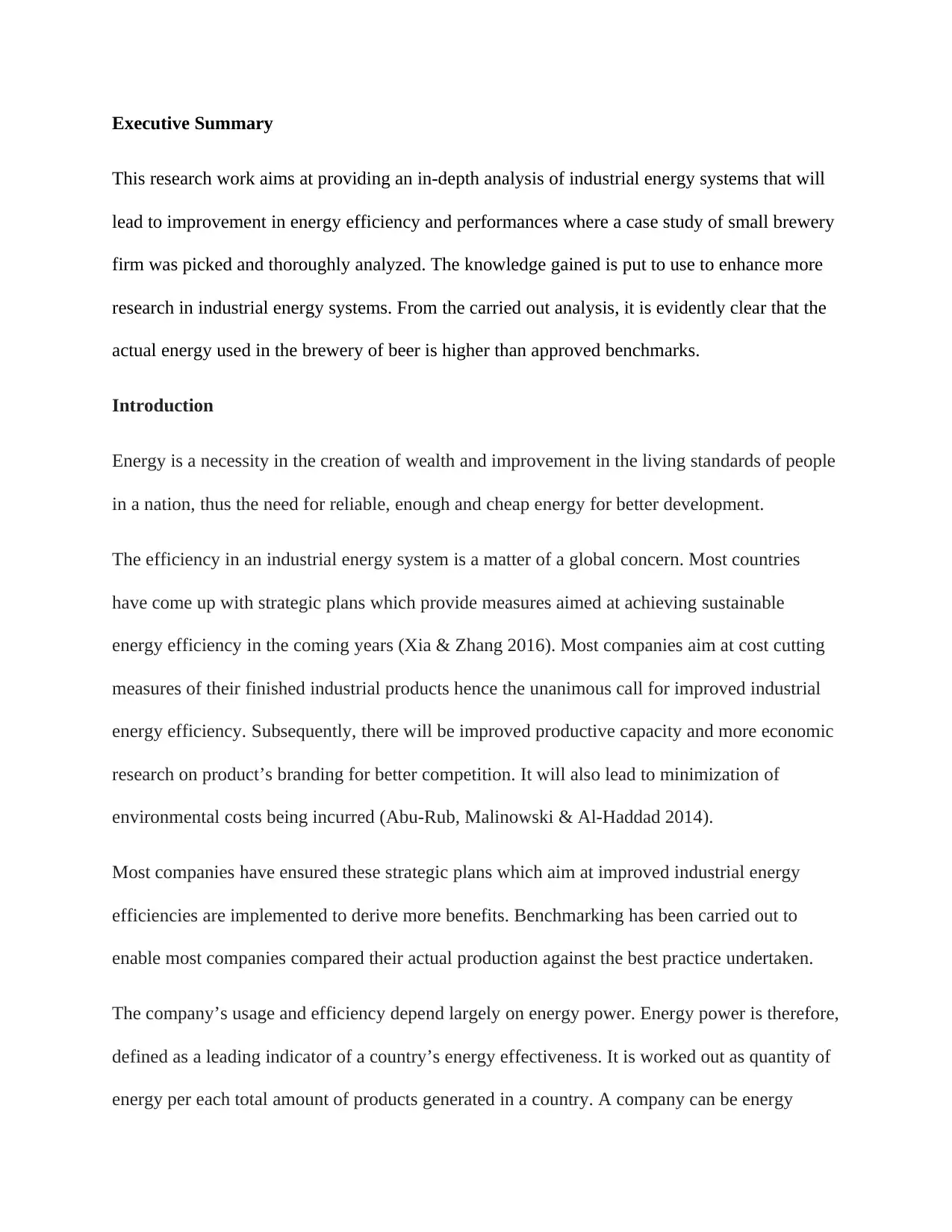
Executive Summary
This research work aims at providing an in-depth analysis of industrial energy systems that will
lead to improvement in energy efficiency and performances where a case study of small brewery
firm was picked and thoroughly analyzed. The knowledge gained is put to use to enhance more
research in industrial energy systems. From the carried out analysis, it is evidently clear that the
actual energy used in the brewery of beer is higher than approved benchmarks.
Introduction
Energy is a necessity in the creation of wealth and improvement in the living standards of people
in a nation, thus the need for reliable, enough and cheap energy for better development.
The efficiency in an industrial energy system is a matter of a global concern. Most countries
have come up with strategic plans which provide measures aimed at achieving sustainable
energy efficiency in the coming years (Xia & Zhang 2016). Most companies aim at cost cutting
measures of their finished industrial products hence the unanimous call for improved industrial
energy efficiency. Subsequently, there will be improved productive capacity and more economic
research on product’s branding for better competition. It will also lead to minimization of
environmental costs being incurred (Abu-Rub, Malinowski & Al-Haddad 2014).
Most companies have ensured these strategic plans which aim at improved industrial energy
efficiencies are implemented to derive more benefits. Benchmarking has been carried out to
enable most companies compared their actual production against the best practice undertaken.
The company’s usage and efficiency depend largely on energy power. Energy power is therefore,
defined as a leading indicator of a country’s energy effectiveness. It is worked out as quantity of
energy per each total amount of products generated in a country. A company can be energy
This research work aims at providing an in-depth analysis of industrial energy systems that will
lead to improvement in energy efficiency and performances where a case study of small brewery
firm was picked and thoroughly analyzed. The knowledge gained is put to use to enhance more
research in industrial energy systems. From the carried out analysis, it is evidently clear that the
actual energy used in the brewery of beer is higher than approved benchmarks.
Introduction
Energy is a necessity in the creation of wealth and improvement in the living standards of people
in a nation, thus the need for reliable, enough and cheap energy for better development.
The efficiency in an industrial energy system is a matter of a global concern. Most countries
have come up with strategic plans which provide measures aimed at achieving sustainable
energy efficiency in the coming years (Xia & Zhang 2016). Most companies aim at cost cutting
measures of their finished industrial products hence the unanimous call for improved industrial
energy efficiency. Subsequently, there will be improved productive capacity and more economic
research on product’s branding for better competition. It will also lead to minimization of
environmental costs being incurred (Abu-Rub, Malinowski & Al-Haddad 2014).
Most companies have ensured these strategic plans which aim at improved industrial energy
efficiencies are implemented to derive more benefits. Benchmarking has been carried out to
enable most companies compared their actual production against the best practice undertaken.
The company’s usage and efficiency depend largely on energy power. Energy power is therefore,
defined as a leading indicator of a country’s energy effectiveness. It is worked out as quantity of
energy per each total amount of products generated in a country. A company can be energy
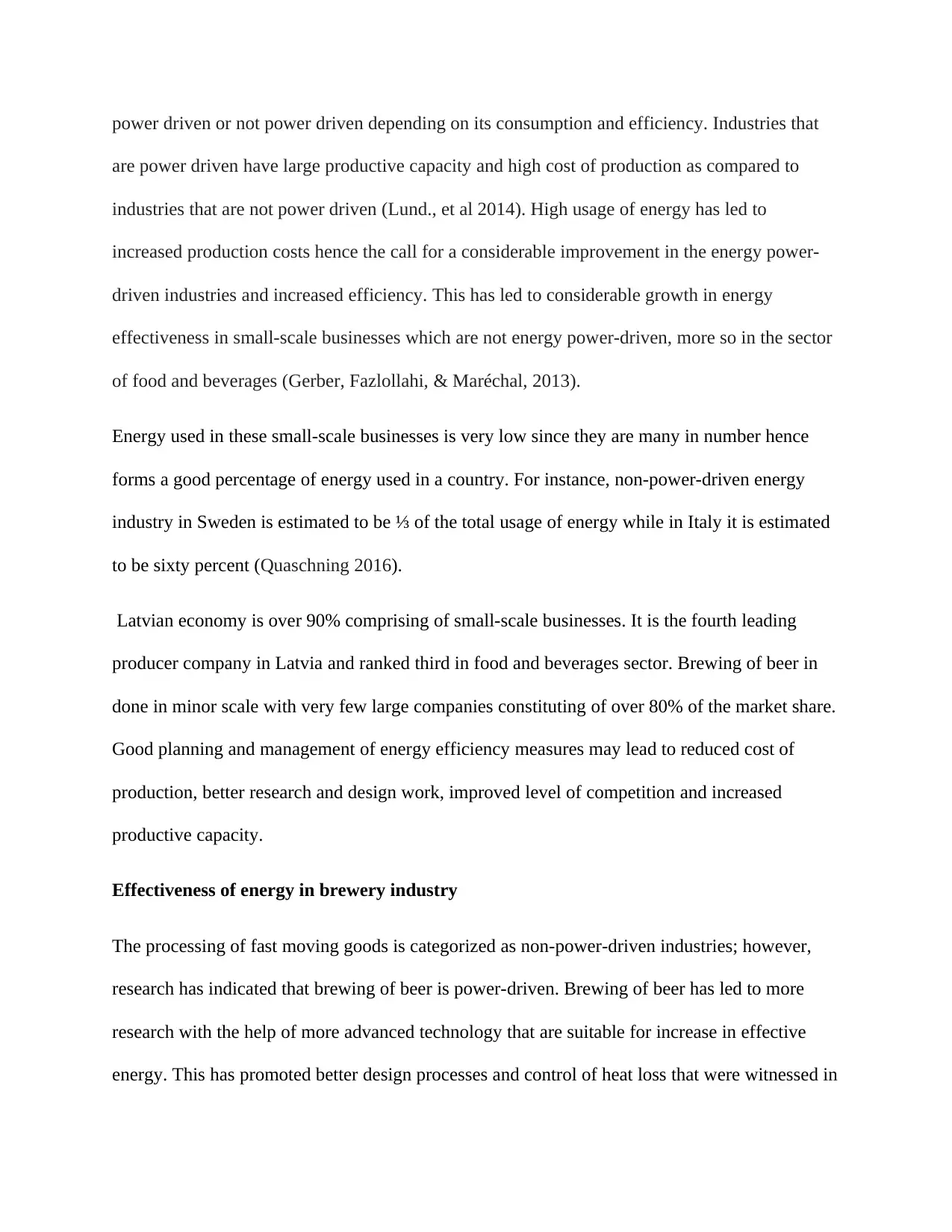
power driven or not power driven depending on its consumption and efficiency. Industries that
are power driven have large productive capacity and high cost of production as compared to
industries that are not power driven (Lund., et al 2014). High usage of energy has led to
increased production costs hence the call for a considerable improvement in the energy power-
driven industries and increased efficiency. This has led to considerable growth in energy
effectiveness in small-scale businesses which are not energy power-driven, more so in the sector
of food and beverages (Gerber, Fazlollahi, & Maréchal, 2013).
Energy used in these small-scale businesses is very low since they are many in number hence
forms a good percentage of energy used in a country. For instance, non-power-driven energy
industry in Sweden is estimated to be ⅓ of the total usage of energy while in Italy it is estimated
to be sixty percent (Quaschning 2016).
Latvian economy is over 90% comprising of small-scale businesses. It is the fourth leading
producer company in Latvia and ranked third in food and beverages sector. Brewing of beer in
done in minor scale with very few large companies constituting of over 80% of the market share.
Good planning and management of energy efficiency measures may lead to reduced cost of
production, better research and design work, improved level of competition and increased
productive capacity.
Effectiveness of energy in brewery industry
The processing of fast moving goods is categorized as non-power-driven industries; however,
research has indicated that brewing of beer is power-driven. Brewing of beer has led to more
research with the help of more advanced technology that are suitable for increase in effective
energy. This has promoted better design processes and control of heat loss that were witnessed in
are power driven have large productive capacity and high cost of production as compared to
industries that are not power driven (Lund., et al 2014). High usage of energy has led to
increased production costs hence the call for a considerable improvement in the energy power-
driven industries and increased efficiency. This has led to considerable growth in energy
effectiveness in small-scale businesses which are not energy power-driven, more so in the sector
of food and beverages (Gerber, Fazlollahi, & Maréchal, 2013).
Energy used in these small-scale businesses is very low since they are many in number hence
forms a good percentage of energy used in a country. For instance, non-power-driven energy
industry in Sweden is estimated to be ⅓ of the total usage of energy while in Italy it is estimated
to be sixty percent (Quaschning 2016).
Latvian economy is over 90% comprising of small-scale businesses. It is the fourth leading
producer company in Latvia and ranked third in food and beverages sector. Brewing of beer in
done in minor scale with very few large companies constituting of over 80% of the market share.
Good planning and management of energy efficiency measures may lead to reduced cost of
production, better research and design work, improved level of competition and increased
productive capacity.
Effectiveness of energy in brewery industry
The processing of fast moving goods is categorized as non-power-driven industries; however,
research has indicated that brewing of beer is power-driven. Brewing of beer has led to more
research with the help of more advanced technology that are suitable for increase in effective
energy. This has promoted better design processes and control of heat loss that were witnessed in
⊘ This is a preview!⊘
Do you want full access?
Subscribe today to unlock all pages.

Trusted by 1+ million students worldwide
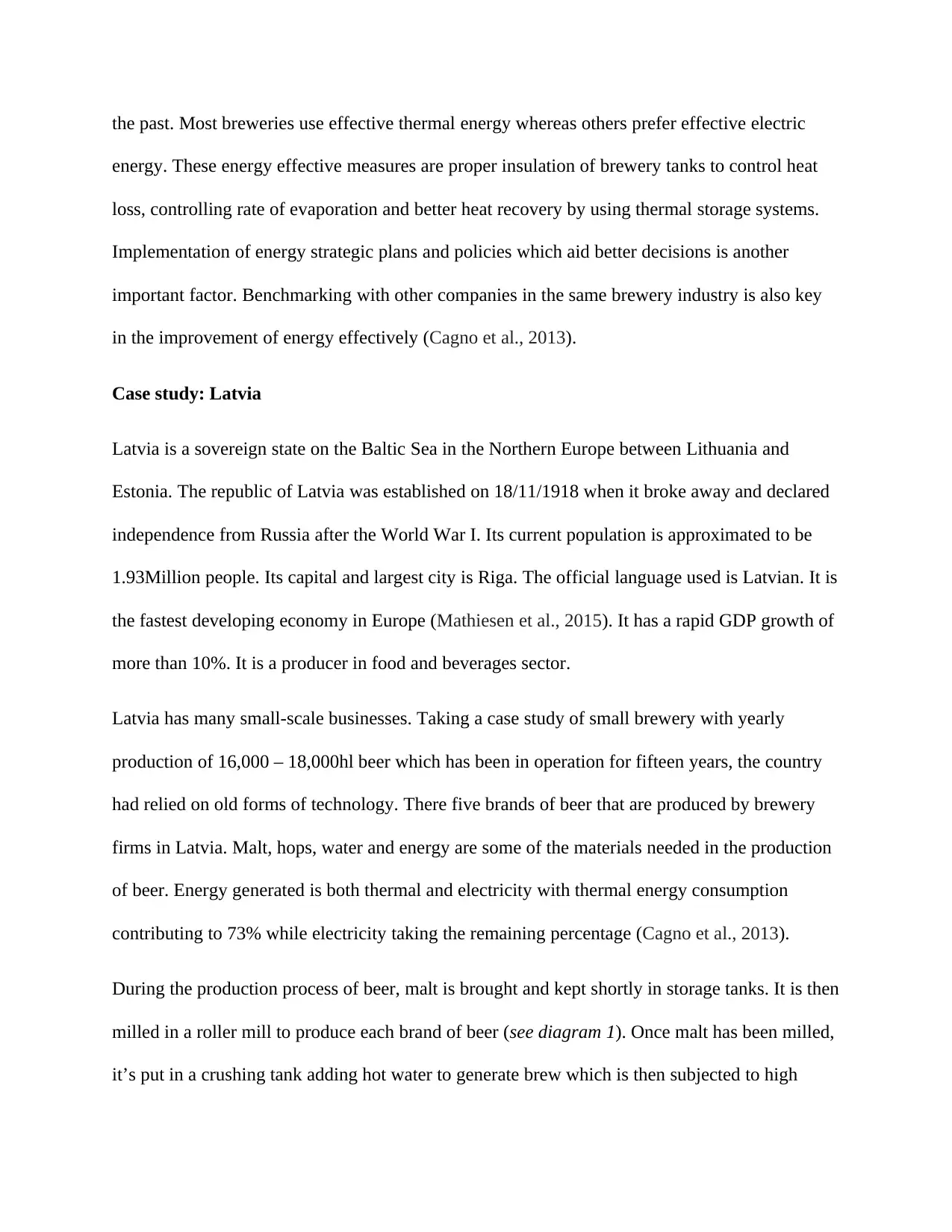
the past. Most breweries use effective thermal energy whereas others prefer effective electric
energy. These energy effective measures are proper insulation of brewery tanks to control heat
loss, controlling rate of evaporation and better heat recovery by using thermal storage systems.
Implementation of energy strategic plans and policies which aid better decisions is another
important factor. Benchmarking with other companies in the same brewery industry is also key
in the improvement of energy effectively (Cagno et al., 2013).
Case study: Latvia
Latvia is a sovereign state on the Baltic Sea in the Northern Europe between Lithuania and
Estonia. The republic of Latvia was established on 18/11/1918 when it broke away and declared
independence from Russia after the World War I. Its current population is approximated to be
1.93Million people. Its capital and largest city is Riga. The official language used is Latvian. It is
the fastest developing economy in Europe (Mathiesen et al., 2015). It has a rapid GDP growth of
more than 10%. It is a producer in food and beverages sector.
Latvia has many small-scale businesses. Taking a case study of small brewery with yearly
production of 16,000 – 18,000hl beer which has been in operation for fifteen years, the country
had relied on old forms of technology. There five brands of beer that are produced by brewery
firms in Latvia. Malt, hops, water and energy are some of the materials needed in the production
of beer. Energy generated is both thermal and electricity with thermal energy consumption
contributing to 73% while electricity taking the remaining percentage (Cagno et al., 2013).
During the production process of beer, malt is brought and kept shortly in storage tanks. It is then
milled in a roller mill to produce each brand of beer (see diagram 1). Once malt has been milled,
it’s put in a crushing tank adding hot water to generate brew which is then subjected to high
energy. These energy effective measures are proper insulation of brewery tanks to control heat
loss, controlling rate of evaporation and better heat recovery by using thermal storage systems.
Implementation of energy strategic plans and policies which aid better decisions is another
important factor. Benchmarking with other companies in the same brewery industry is also key
in the improvement of energy effectively (Cagno et al., 2013).
Case study: Latvia
Latvia is a sovereign state on the Baltic Sea in the Northern Europe between Lithuania and
Estonia. The republic of Latvia was established on 18/11/1918 when it broke away and declared
independence from Russia after the World War I. Its current population is approximated to be
1.93Million people. Its capital and largest city is Riga. The official language used is Latvian. It is
the fastest developing economy in Europe (Mathiesen et al., 2015). It has a rapid GDP growth of
more than 10%. It is a producer in food and beverages sector.
Latvia has many small-scale businesses. Taking a case study of small brewery with yearly
production of 16,000 – 18,000hl beer which has been in operation for fifteen years, the country
had relied on old forms of technology. There five brands of beer that are produced by brewery
firms in Latvia. Malt, hops, water and energy are some of the materials needed in the production
of beer. Energy generated is both thermal and electricity with thermal energy consumption
contributing to 73% while electricity taking the remaining percentage (Cagno et al., 2013).
During the production process of beer, malt is brought and kept shortly in storage tanks. It is then
milled in a roller mill to produce each brand of beer (see diagram 1). Once malt has been milled,
it’s put in a crushing tank adding hot water to generate brew which is then subjected to high
Paraphrase This Document
Need a fresh take? Get an instant paraphrase of this document with our AI Paraphraser
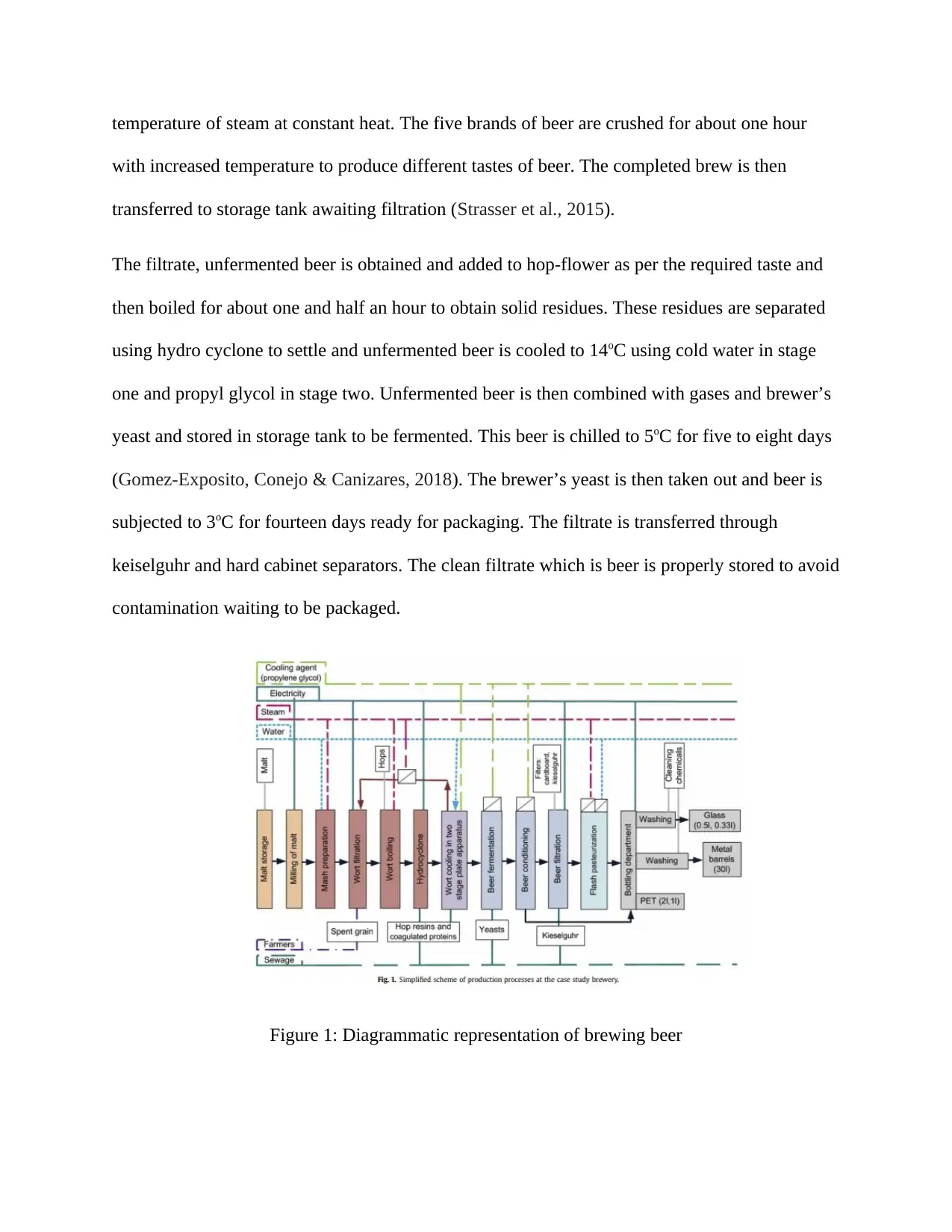
temperature of steam at constant heat. The five brands of beer are crushed for about one hour
with increased temperature to produce different tastes of beer. The completed brew is then
transferred to storage tank awaiting filtration (Strasser et al., 2015).
The filtrate, unfermented beer is obtained and added to hop-flower as per the required taste and
then boiled for about one and half an hour to obtain solid residues. These residues are separated
using hydro cyclone to settle and unfermented beer is cooled to 14oC using cold water in stage
one and propyl glycol in stage two. Unfermented beer is then combined with gases and brewer’s
yeast and stored in storage tank to be fermented. This beer is chilled to 5oC for five to eight days
(Gomez-Exposito, Conejo & Canizares, 2018). The brewer’s yeast is then taken out and beer is
subjected to 3oC for fourteen days ready for packaging. The filtrate is transferred through
keiselguhr and hard cabinet separators. The clean filtrate which is beer is properly stored to avoid
contamination waiting to be packaged.
Figure 1: Diagrammatic representation of brewing beer
with increased temperature to produce different tastes of beer. The completed brew is then
transferred to storage tank awaiting filtration (Strasser et al., 2015).
The filtrate, unfermented beer is obtained and added to hop-flower as per the required taste and
then boiled for about one and half an hour to obtain solid residues. These residues are separated
using hydro cyclone to settle and unfermented beer is cooled to 14oC using cold water in stage
one and propyl glycol in stage two. Unfermented beer is then combined with gases and brewer’s
yeast and stored in storage tank to be fermented. This beer is chilled to 5oC for five to eight days
(Gomez-Exposito, Conejo & Canizares, 2018). The brewer’s yeast is then taken out and beer is
subjected to 3oC for fourteen days ready for packaging. The filtrate is transferred through
keiselguhr and hard cabinet separators. The clean filtrate which is beer is properly stored to avoid
contamination waiting to be packaged.
Figure 1: Diagrammatic representation of brewing beer
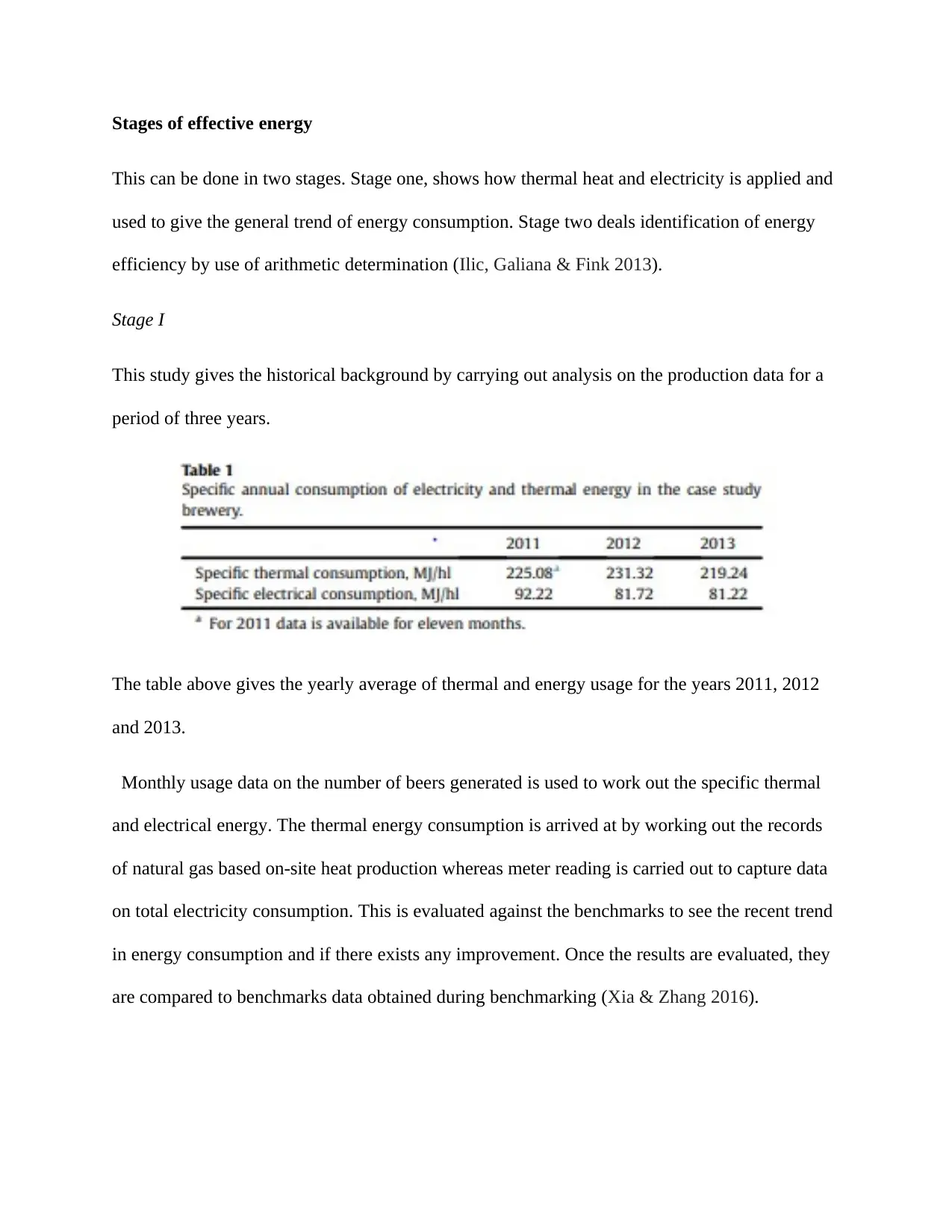
Stages of effective energy
This can be done in two stages. Stage one, shows how thermal heat and electricity is applied and
used to give the general trend of energy consumption. Stage two deals identification of energy
efficiency by use of arithmetic determination (Ilic, Galiana & Fink 2013).
Stage I
This study gives the historical background by carrying out analysis on the production data for a
period of three years.
The table above gives the yearly average of thermal and energy usage for the years 2011, 2012
and 2013.
Monthly usage data on the number of beers generated is used to work out the specific thermal
and electrical energy. The thermal energy consumption is arrived at by working out the records
of natural gas based on-site heat production whereas meter reading is carried out to capture data
on total electricity consumption. This is evaluated against the benchmarks to see the recent trend
in energy consumption and if there exists any improvement. Once the results are evaluated, they
are compared to benchmarks data obtained during benchmarking (Xia & Zhang 2016).
This can be done in two stages. Stage one, shows how thermal heat and electricity is applied and
used to give the general trend of energy consumption. Stage two deals identification of energy
efficiency by use of arithmetic determination (Ilic, Galiana & Fink 2013).
Stage I
This study gives the historical background by carrying out analysis on the production data for a
period of three years.
The table above gives the yearly average of thermal and energy usage for the years 2011, 2012
and 2013.
Monthly usage data on the number of beers generated is used to work out the specific thermal
and electrical energy. The thermal energy consumption is arrived at by working out the records
of natural gas based on-site heat production whereas meter reading is carried out to capture data
on total electricity consumption. This is evaluated against the benchmarks to see the recent trend
in energy consumption and if there exists any improvement. Once the results are evaluated, they
are compared to benchmarks data obtained during benchmarking (Xia & Zhang 2016).
⊘ This is a preview!⊘
Do you want full access?
Subscribe today to unlock all pages.

Trusted by 1+ million students worldwide
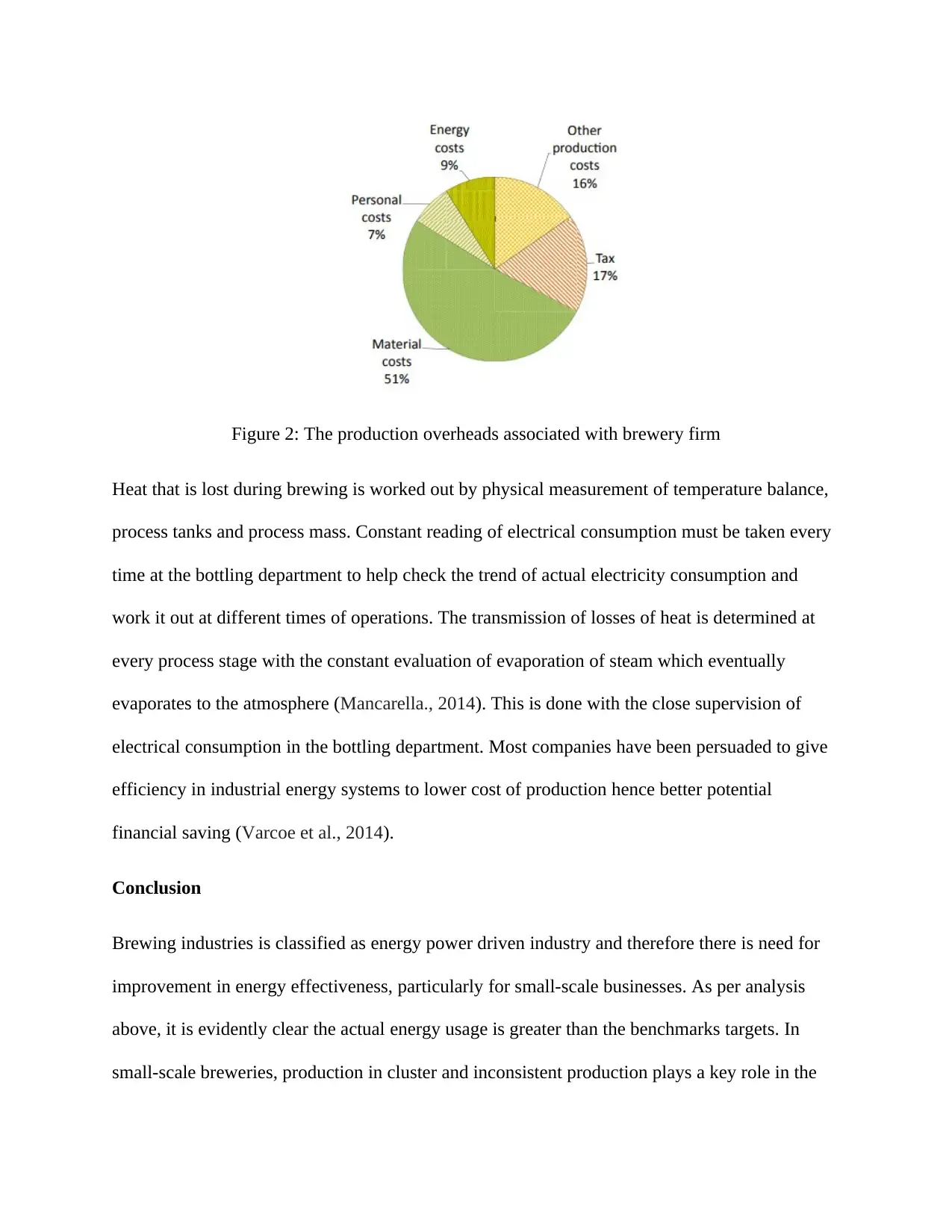
Figure 2: The production overheads associated with brewery firm
Heat that is lost during brewing is worked out by physical measurement of temperature balance,
process tanks and process mass. Constant reading of electrical consumption must be taken every
time at the bottling department to help check the trend of actual electricity consumption and
work it out at different times of operations. The transmission of losses of heat is determined at
every process stage with the constant evaluation of evaporation of steam which eventually
evaporates to the atmosphere (Mancarella., 2014). This is done with the close supervision of
electrical consumption in the bottling department. Most companies have been persuaded to give
efficiency in industrial energy systems to lower cost of production hence better potential
financial saving (Varcoe et al., 2014).
Conclusion
Brewing industries is classified as energy power driven industry and therefore there is need for
improvement in energy effectiveness, particularly for small-scale businesses. As per analysis
above, it is evidently clear the actual energy usage is greater than the benchmarks targets. In
small-scale breweries, production in cluster and inconsistent production plays a key role in the
Heat that is lost during brewing is worked out by physical measurement of temperature balance,
process tanks and process mass. Constant reading of electrical consumption must be taken every
time at the bottling department to help check the trend of actual electricity consumption and
work it out at different times of operations. The transmission of losses of heat is determined at
every process stage with the constant evaluation of evaporation of steam which eventually
evaporates to the atmosphere (Mancarella., 2014). This is done with the close supervision of
electrical consumption in the bottling department. Most companies have been persuaded to give
efficiency in industrial energy systems to lower cost of production hence better potential
financial saving (Varcoe et al., 2014).
Conclusion
Brewing industries is classified as energy power driven industry and therefore there is need for
improvement in energy effectiveness, particularly for small-scale businesses. As per analysis
above, it is evidently clear the actual energy usage is greater than the benchmarks targets. In
small-scale breweries, production in cluster and inconsistent production plays a key role in the
Paraphrase This Document
Need a fresh take? Get an instant paraphrase of this document with our AI Paraphraser

usage of energy. To determine high energy uptake, analysis of the industry’s data is determined
and evaluated. This will necessitate the research work that will ensure that several hurdles in
industrial energy consumption are eliminated hence improved energy management and better
operation planning. This will lead to reduced cost of operation and improved energy efficiency.
and evaluated. This will necessitate the research work that will ensure that several hurdles in
industrial energy consumption are eliminated hence improved energy management and better
operation planning. This will lead to reduced cost of operation and improved energy efficiency.
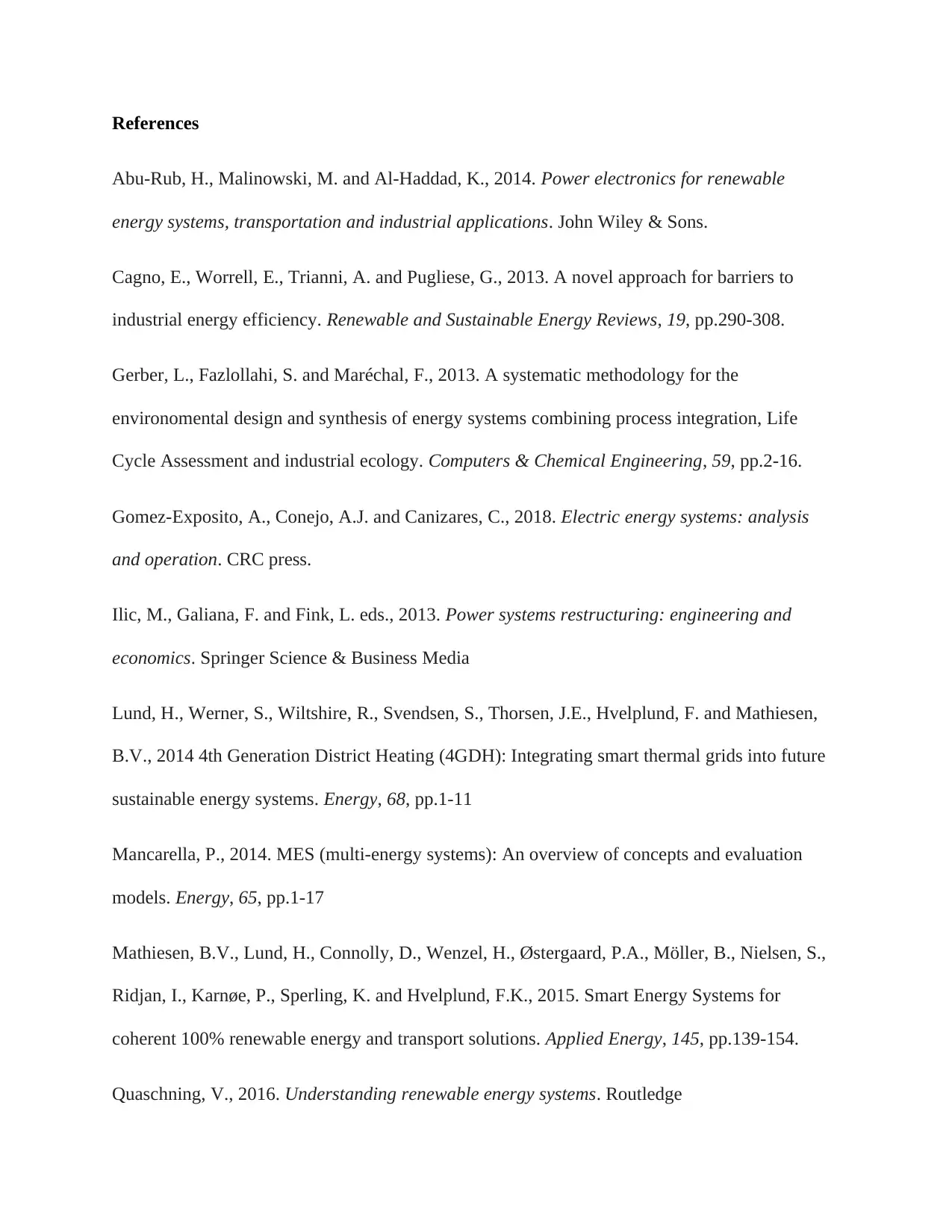
References
Abu-Rub, H., Malinowski, M. and Al-Haddad, K., 2014. Power electronics for renewable
energy systems, transportation and industrial applications. John Wiley & Sons.
Cagno, E., Worrell, E., Trianni, A. and Pugliese, G., 2013. A novel approach for barriers to
industrial energy efficiency. Renewable and Sustainable Energy Reviews, 19, pp.290-308.
Gerber, L., Fazlollahi, S. and Maréchal, F., 2013. A systematic methodology for the
environomental design and synthesis of energy systems combining process integration, Life
Cycle Assessment and industrial ecology. Computers & Chemical Engineering, 59, pp.2-16.
Gomez-Exposito, A., Conejo, A.J. and Canizares, C., 2018. Electric energy systems: analysis
and operation. CRC press.
Ilic, M., Galiana, F. and Fink, L. eds., 2013. Power systems restructuring: engineering and
economics. Springer Science & Business Media
Lund, H., Werner, S., Wiltshire, R., Svendsen, S., Thorsen, J.E., Hvelplund, F. and Mathiesen,
B.V., 2014 4th Generation District Heating (4GDH): Integrating smart thermal grids into future
sustainable energy systems. Energy, 68, pp.1-11
Mancarella, P., 2014. MES (multi-energy systems): An overview of concepts and evaluation
models. Energy, 65, pp.1-17
Mathiesen, B.V., Lund, H., Connolly, D., Wenzel, H., Østergaard, P.A., Möller, B., Nielsen, S.,
Ridjan, I., Karnøe, P., Sperling, K. and Hvelplund, F.K., 2015. Smart Energy Systems for
coherent 100% renewable energy and transport solutions. Applied Energy, 145, pp.139-154.
Quaschning, V., 2016. Understanding renewable energy systems. Routledge
Abu-Rub, H., Malinowski, M. and Al-Haddad, K., 2014. Power electronics for renewable
energy systems, transportation and industrial applications. John Wiley & Sons.
Cagno, E., Worrell, E., Trianni, A. and Pugliese, G., 2013. A novel approach for barriers to
industrial energy efficiency. Renewable and Sustainable Energy Reviews, 19, pp.290-308.
Gerber, L., Fazlollahi, S. and Maréchal, F., 2013. A systematic methodology for the
environomental design and synthesis of energy systems combining process integration, Life
Cycle Assessment and industrial ecology. Computers & Chemical Engineering, 59, pp.2-16.
Gomez-Exposito, A., Conejo, A.J. and Canizares, C., 2018. Electric energy systems: analysis
and operation. CRC press.
Ilic, M., Galiana, F. and Fink, L. eds., 2013. Power systems restructuring: engineering and
economics. Springer Science & Business Media
Lund, H., Werner, S., Wiltshire, R., Svendsen, S., Thorsen, J.E., Hvelplund, F. and Mathiesen,
B.V., 2014 4th Generation District Heating (4GDH): Integrating smart thermal grids into future
sustainable energy systems. Energy, 68, pp.1-11
Mancarella, P., 2014. MES (multi-energy systems): An overview of concepts and evaluation
models. Energy, 65, pp.1-17
Mathiesen, B.V., Lund, H., Connolly, D., Wenzel, H., Østergaard, P.A., Möller, B., Nielsen, S.,
Ridjan, I., Karnøe, P., Sperling, K. and Hvelplund, F.K., 2015. Smart Energy Systems for
coherent 100% renewable energy and transport solutions. Applied Energy, 145, pp.139-154.
Quaschning, V., 2016. Understanding renewable energy systems. Routledge
⊘ This is a preview!⊘
Do you want full access?
Subscribe today to unlock all pages.

Trusted by 1+ million students worldwide
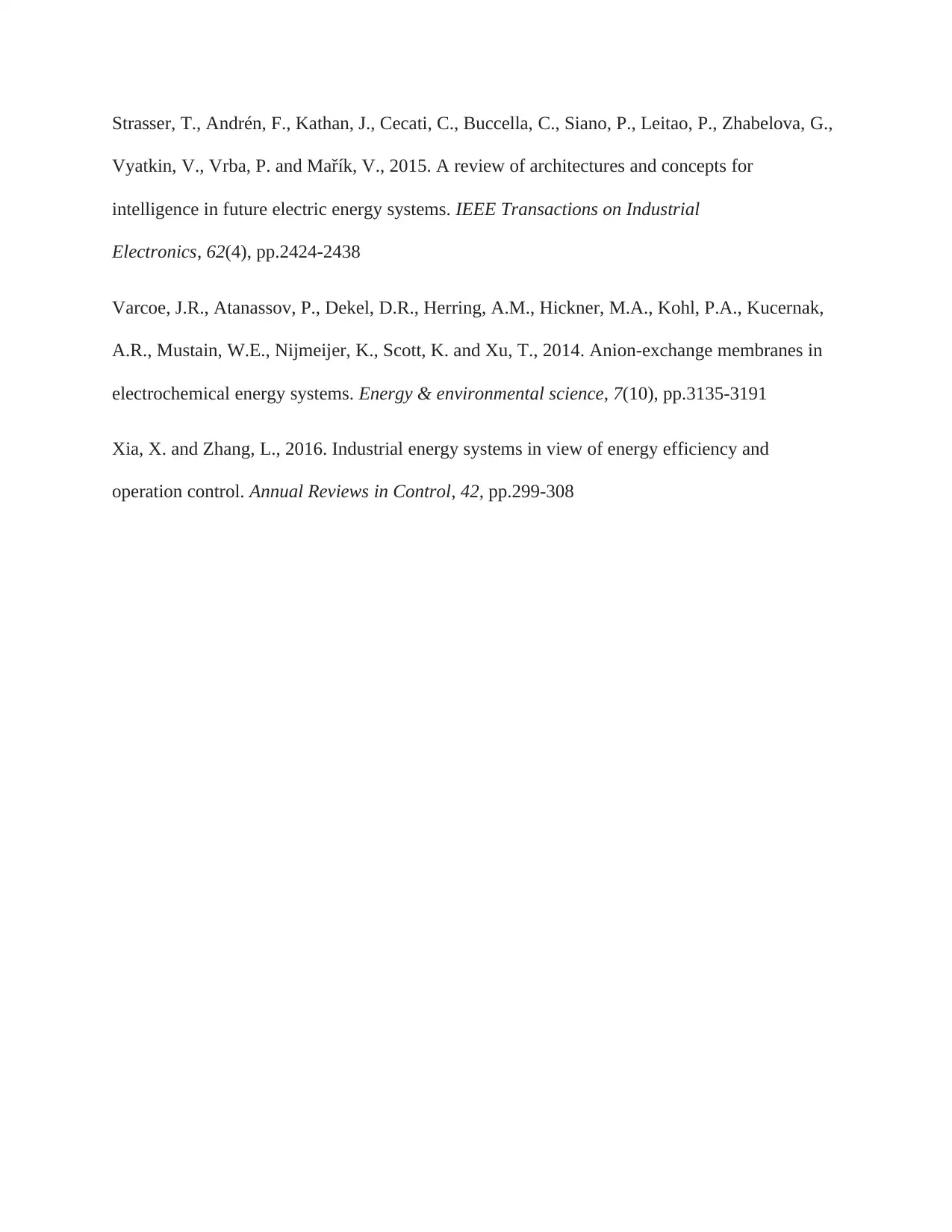
Strasser, T., Andrén, F., Kathan, J., Cecati, C., Buccella, C., Siano, P., Leitao, P., Zhabelova, G.,
Vyatkin, V., Vrba, P. and Mařík, V., 2015. A review of architectures and concepts for
intelligence in future electric energy systems. IEEE Transactions on Industrial
Electronics, 62(4), pp.2424-2438
Varcoe, J.R., Atanassov, P., Dekel, D.R., Herring, A.M., Hickner, M.A., Kohl, P.A., Kucernak,
A.R., Mustain, W.E., Nijmeijer, K., Scott, K. and Xu, T., 2014. Anion-exchange membranes in
electrochemical energy systems. Energy & environmental science, 7(10), pp.3135-3191
Xia, X. and Zhang, L., 2016. Industrial energy systems in view of energy efficiency and
operation control. Annual Reviews in Control, 42, pp.299-308
Vyatkin, V., Vrba, P. and Mařík, V., 2015. A review of architectures and concepts for
intelligence in future electric energy systems. IEEE Transactions on Industrial
Electronics, 62(4), pp.2424-2438
Varcoe, J.R., Atanassov, P., Dekel, D.R., Herring, A.M., Hickner, M.A., Kohl, P.A., Kucernak,
A.R., Mustain, W.E., Nijmeijer, K., Scott, K. and Xu, T., 2014. Anion-exchange membranes in
electrochemical energy systems. Energy & environmental science, 7(10), pp.3135-3191
Xia, X. and Zhang, L., 2016. Industrial energy systems in view of energy efficiency and
operation control. Annual Reviews in Control, 42, pp.299-308
1 out of 10
Related Documents
Your All-in-One AI-Powered Toolkit for Academic Success.
+13062052269
info@desklib.com
Available 24*7 on WhatsApp / Email
![[object Object]](/_next/static/media/star-bottom.7253800d.svg)
Unlock your academic potential
Copyright © 2020–2025 A2Z Services. All Rights Reserved. Developed and managed by ZUCOL.





